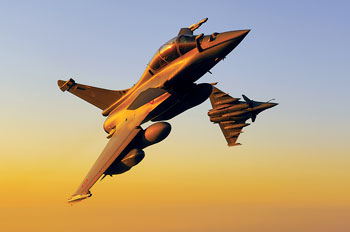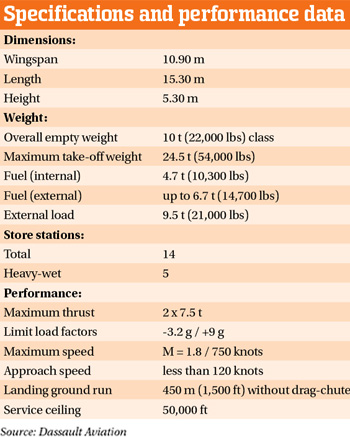INDIAN ARMED FORCES CHIEFS ON
OUR RELENTLESS AND FOCUSED PUBLISHING EFFORTS

SP Guide Publications puts forth a well compiled articulation of issues, pursuits and accomplishments of the Indian Army, over the years

I am confident that SP Guide Publications would continue to inform, inspire and influence.

My compliments to SP Guide Publications for informative and credible reportage on contemporary aerospace issues over the past six decades.
- Prime Minister witnesses 'Bharat Shakti' – a Tri-Services Firing and Manoeuvre Exercise in Pokhran, Rajasthan
- Interim Defence Budget 2024-25 — An Analysis
- Union Defence budget 2024
- Prime Minister Modi Commemorates Indian Navy Day in a Grand Ceremony
- Prime Minister Modi Flies in the LCA Tejas
- New Chapter in India-Italy Defence Ties
- Airpower beyond Boundaries
A welcome breakthrough!
With the breakthrough in the deal of the 36 Rafale jets, finally, there is the proverbial ‘light at the end of the tunnel’!
 |
By Air Marshal B.K. Pandey (Retd) Former Air Officer Commanding-in-Chief of Training Command, IAF |

After protracted negotiations that have been going on for the last one year between the Indian Ministry of Defence (MoD) and Dassault Aviation of France, for the purchase of 36 Rafale medium multi-role combat aircraft (MMRCA) in fly-away condition appears to have reached the “final stage”. As against the total cost of the project pitched initially by Dassault Aviation at $12 billion (Euros 11 billion or Rs. 80,000 crore), the representatives of the MoD involved in the contract negotiations have succeeded in scaling down the financial burden substantially and are reported to have finalised the cost of the project at $8.8 billion (Euros 7.8 billion or nearly Rs 59,000 crore). Subject to no further impediments, the contract is expected to be signed within three to four weeks from now and the first few aircraft are expected to be delivered within 18 months of the date the contract is signed. This indeed is a welcome breakthrough especially for the Indian Air Force (IAF) whose efforts to procure the MMRCA since 2002 had so far failed to fructify. This breakthrough has come nearly three months after Prime Minister Narendra Modi and French President Francois Hollande signed a memorandum of understanding (MoU) for the direct purchase of 36 Rafale combat jets when President Francois Hollande had been invited as the Chief Guest at the Republic Day Parade and related functions in Delhi this year.

With the significant tempering of the value of the contract, for Dassault, it is a significant climb down as the original equipment manufacturer has also agreed to an ‘offsets obligation’ of 50 per cent of the value of the contract as against its original stand of 30 per cent. French companies such as Safran and Thales will join Dassault in providing state-of-art technologies in the regime of stealth, radar, thrust vectoring for missiles and materials for electronics and micro-electronics. For its part, the Indian aerospace industry can look forward to infusion of a healthy dose funds to the extent of $4.4 billion. If these funds are correctly utilised, the Indian aerospace industry can and should receive the necessary impetus to scale greater heights.
The fact that this Government-to-Government deal for the 36 Rafale MMRCA has been finalised within a year of the initial informal agreement between French President Francois Hollande and Prime Minister Narendra Modi and that the IAF can expect to induct the first aircraft before the end of 2017, only serve to reinforce the belief that for procurement of urgently required high value military hardware for the Indian armed forces, direct deals with governments involved would be a far better option as compared the system of global tender mandated under the Defence Procurement Procedure (DPP) that had been in vogue for some years. Incidentally, the latest version of this document dubbed as DPP 2016, was unveiled by Defence Minister Manohar Parrikar at Defexpo 2016 at Goa in March this year. However, DPP 2016 is yet to be put through baptism by fire to establish its efficacy. As per the original tender for the MMRCA floated in August 2007, the IAF was to receive 126 aircraft equivalent of six squadrons. The deal for 36 Rafale jets currently in progress, would provide the IAF with partial relief with the induction of just two combat squadrons. The numbers are clearly inadequate to address the debilitating shortages in its fleet of combat aircraft that the IAF is confronted with. Options therefore need to be explored to find ways to close the ever-widening and crippling gap that is destined to worsen in the next few years in the combat fleet if no urgent steps are taken to fast-track building of fourth-plus or fifth generation combat platforms in the numbers required to restore the operational edge of the IAF against its potential adversaries. Following the realisation of the contract under discussion, one of the options before the nation would be to explore the possibility of manufacturing the Rafale jets in India under the Make in India scheme both for the Indian and global markets.
With the breakthrough in the deal of the 36 Rafale jets, finally, there is the proverbial ‘light at the end of the tunnel’!





